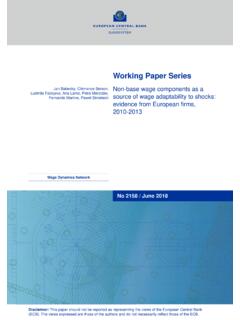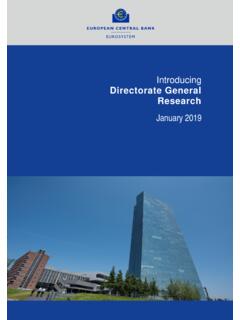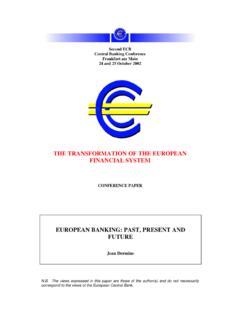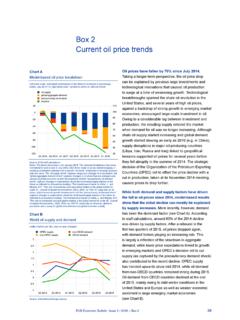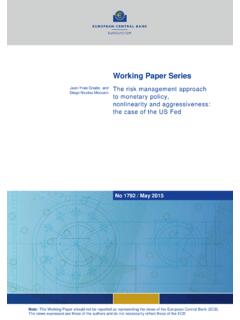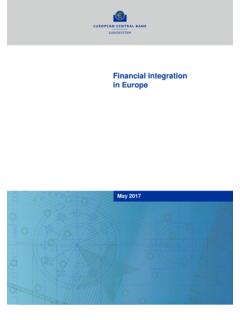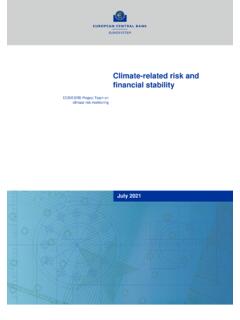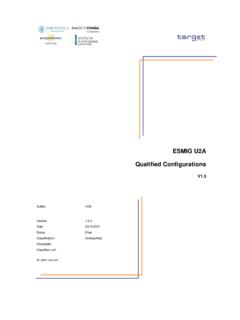Transcription of CYBER RESILIENCE OVERSIGHT EXPECTATIONS …
1 Page 1 of 66 ECB-PUBLIC CYBER RESILIENCE OVERSIGHT EXPECTATIONS (CROE) FOR FINANCIAL MARKET infrastructures ECB-PUBLIC Page 2 of 66 Table of contents 1. INTRODUCTION 4 Background 4 Purpose 5 Addressees 6 Requirements by type of FMI 7 Levels of maturity 7 Requirements 8 Structure of the document 9 2. CYBER RESILIENCE OVERSIGHT EXPECTATIONS 11 GOVERNANCE 11 Governance - Preamble 11 Governance - EXPECTATIONS 11 CYBER RESILIENCE strategy and framework 11 Role of the board and senior management 15 IDENTIFICATION 21 Identification - Preamble 21 Identification - EXPECTATIONS 21 PROTECTION 24 Protection - Preamble 24 Protection - EXPECTATIONS 24 Protection of processes and assets 24 Control implementation and design: 24 Network & infrastructure management.
2 26 Logical & physical security management 29 Change & patch management: 31 People management 33 Human resources security: 33 Security awareness and training: 34 Supplier and third-party security management 35 DETECTION 37 Detection - Preamble 37 Detection - EXPECTATIONS 37 RESPONSE AND RECOVERY 40 ECB-PUBLIC Page 3 of 66 Response and recovery - Preamble 40 Response and recovery - EXPECTATIONS 40 CYBER RESILIENCE incident management 40 Data integrity: 43 Communication and collaboration 44 Contagion: 44 Crisis communication and responsible disclosure: 45 Forensic readiness 46 TESTING 48 Testing - Preamble 48 Testing - EXPECTATIONS 48 SITUATIONAL AWARENESS 54 Situational awareness - Preamble 54 Situational awareness - EXPECTATIONS 54 CYBER threat intelligence 54 Information sharing 57 LEARNING AND EVOLVING 59 Learning and evolving - Preamble 59 Learning and evolving - EXPECTATIONS 59 ANNEX 1 - GLOSSARY 62 ANNEX 2 - ABBREVIATIONS 64 ANNEX 3 GUIDANCE ON THE SENIOR EXECUTIVE 65 ECB-PUBLIC Page 4 of 66 1.
3 INTRODUCTION Background The safe and efficient operation of financial market infrastructures (FMIs) is essential to maintaining and promoting financial stability and economic growth. If not properly managed, FMIs can be sources of financial shocks, such as liquidity dislocations and credit losses, or a major channel through which these shocks are transmitted across domestic and international financial markets. In this context, the level of CYBER RESILIENCE , which contributes to an FMI s operational RESILIENCE , can be a decisive fa ctor in the overall RESILIENCE of the financial system and the broader economy.
4 In June 2016, CPMI-IOSCO published the CPMI-IOSCO Guidance on CYBER RESILIENCE for financial market infrastructures (Guidance)1, which requires FMIs to immediately take the necessary steps to implement it, in concert with relevant stakeholders, to ensure that they enhance their levels of CYBER RESILIENCE . While CYBER risks should be managed as part of an FMI s overall operational risk management framework, some unique characteristics of CYBER risk, as noted in the Guidance, present challenges to FMIs traditional operational risk management frameworks: First, a distinguishing characteristic of sophisticated CYBER attacks is the persistent nature of a campaign conducted by a motivated attacker.
5 The presence of an active, persistent and sometimes sophisticated adversary in CYBER attacks means that, unlike most other sources of risk, malicious CYBER attacks are often difficult to identify or fully eradicate and the breadth of impact difficult to determine. Second, there is a broad range of entry points through which an FMI could be compromised. As a result of their interconnectedness, CYBER attacks could arise through FMIs participants, linked FMIs, service providers, vendors and vendor products. FMIs could themselves become a channel to further propagate CYBER attacks for example, via the distribution of malware to interconnected entities.
6 Unlike physical operational disruptions, CYBER risk posed by an interconnected entity 1 ECB-PUBLIC Page 5 of 66 is not necessarily related to the degree of that entity s relevance to the FMI s business. From a CYBER perspective, the small-value/volume participant or a vendor providing non-critical services may be as risky as a major participant or a critical service provider. Internally, the risk of an insider threat from rogue or careless employees opens up yet another avenue for possible compromises.
7 Third, certain CYBER attacks can render some risk management and business continuity arrangements ineffective. For example, automated system and data replication arrangements that are designed to help preserve sensitive data and software in the event of a physical disruptive event might, in some instances, fuel the propagation of malware and corrupted data to backup systems. Overall, a CYBER attack s potential to cause significant service disruption of the broader financial system dictates the urgency of having an effective approach in place to manage it, and to minimise the probability that service resumption will introduce additional risks to an FMI or the wider financial sector.
8 Fourth, CYBER attacks can be stealthy and propagate rapidly within a network of systems. For example, they can exploit unknown vulnerabilities and weak links in systems and protocols to cause disruption and/or infiltrate an FMI s internal network. Malware designed to take advantage of such latent vulnerabilities may circumvent controls. To minimise the impact of such attacks, FMIs would require capabilities to swiftly detect, respond to, contain and recover from such attacks. Therefore, FMIs should continuously work to enhance their CYBER RESILIENCE capabilities with the objective of limiting the escalating risks that CYBER threats pose to both the FMI itself and its overall ecosystem.
9 Purpose FMIs are required to comply with the Guidance immediately, and overseers must simultaneously develop an OVERSIGHT approach to assess their FMIs against the Guidance. In this context, the CYBER RESILIENCE OVERSIGHT EXPECTATIONS (CROE) serves three key purposes: (i) it provides overseers with clear EXPECTATIONS to assess the FMIs under their responsibility and determine their CYBER RESILIENCE maturity levels; (ii) it ECB-PUBLIC Page 6 of 66 provides FMIs with detailed steps on how to operationalise the Guidance, ensuring they are able to foster improvements and enhance their CYBER RESILIENCE over a sustained period of time.
10 And (iii) it provides the basis for a meaningful discussion between the FMIs and their respective overseers. The CROE are predicated on the Guidance and leverage off the existing CPSS-IOSCO Principles for financial market infrastructures (PFMIs) to ensure a full and coherent set of EXPECTATIONS . Additionally, whilst developing the CROE, the Eurosystem OVERSIGHT function also considered existing international guidance documents and frameworks. In particular, the NIST Cybersecurity Framework, ISO/IEC 27002, COBIT 5, Information Security Forum s Standard of Good Practice for Information Security and Federal Financial Institutions Examination Council s (FFIEC) Cybersecurity Assessment Tool were used as a basis.
